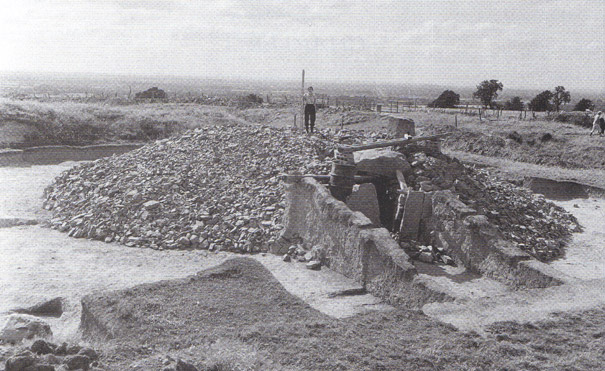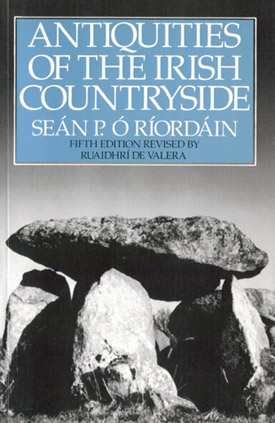Ruaidhrí de Valera (1916–1978)
Rúaidhrí (Rory) de Valera, an Irish archaeology was born in Dublin in 1916, de Valera's passion for ancient history and culture led him to pursue a career in archaeology. Throughout his career, he made significant contributions to the understanding of Ireland's ancient past, particularly through his meticulous studies of megalithic tombs.His pioneering research shed new light on the construction techniques, cultural significance, and societal contexts of these enigmatic structures. Beyond his scholarly endeavors, de Valera was deeply committed to preserving Ireland's archaeological heritage and promoting the importance of historical understanding. His legacy extends not only through his academic achievements but also through his advocacy for the preservation and appreciation of Ireland's rich cultural heritage.

Hill of Tara, Mound of the Hostages after removal of the earthen mound in 1959
Ruaidhrí de Valera - Irish Archaeologist
Ruaidhrí de Valera was born in Dublin on November 3, 1916. He was the fourth son of Éamon de Valera and Sinéad de Valera. He went to Blackrock College initially and later attended University College Dublin (UCD) starting in 1935. At UCD, he was active in Irish-language groups and earned a BA in Celtic studies in 1939.He served in the Irish army from 1940 to 1942. Afterward, he became a lecturer in Old Irish and Welsh at Maynooth College from 1942 to 1943 before returning to UCD for postgraduate study. In 1945, he earned an MA for his thesis on the megalithic tombs of north-east Clare.
He furthered his studies on Irish megalithic tombs and in 1947, he was appointed as an archaeology officer for the ordnance survey. During his time there, he collaborated with Seán Ó Nualláin on groundbreaking studies. Their work resulted in the publication of "Surveys of the megalithic tombs of Ireland" in three volumes between 1961 and 1972. His Ph.D. thesis in 1954 introduced innovative ideas into the field.
In November 1957, he became a professor of Celtic archaeology at UCD, where he oversaw the department's significant expansion. He was instrumental in advancing the study of prehistory and in promoting the use of Irish in academic writing and lectures. He also played a key role in developing appropriate archaeological terminology. He held various positions of leadership, including vice-president of the Royal Society of Antiquaries of Ireland, dean of the faculty of Celtic studies at UCD, and a member of the senate of the National University of Ireland. He was also passionate about the Irish language and unity, serving as president of An Comhchaidreamh, an inter-university Gaelic organization.
In 1956, after two seasons excavation at the Mound of the Hostages on the Hill of Tara, Prof Ó Ríordáin became ill. He died in 1957. Ruaidhrí de Valera completed the excavation of the megalithic passage tomb in 1959.
De Valera was known for his imaginative thinking in academia, particularly in recognizing the significance of megalithic tombs in understanding prehistory. He was dedicated to evening students, academic freedom, and maintaining UCD's independence from government and corporate influence. He opposed the merger of UCD and Trinity College Dublin and was aligned with the Wood Quay protesters.
He died suddenly on October 28, 1978, in Enniskillen during an academic conference, following a debate on megalithic tombs, surrounded by many of his former students.
Antiquities of the Irish Countryside
 Antiquities of the Irish Countryside by Seán P. Ó Ríordáin.
First Published in 1942, Fifth Edition revised by Ruaidhrí de Valera in 1979.
Antiquities of the Irish Countryside by Seán P. Ó Ríordáin.
First Published in 1942, Fifth Edition revised by Ruaidhrí de Valera in 1979.
From the preface to the First Edition (Cork University Press, 1942)
This booklet is not intended for specialists in archaeology. Its purpose is to give some answer to the questioning man in the street, who asks the archaeologist for a simple explanation of some monument which he has noticed in the countryside and which is, in all probability, a typical example of a class of antiquity widespread throughout Ireland.
The question usually concerns an individual structure, be it fort, souterrain, stone circle, or other antiquity, of which the archaeologist, lacking evidence which excavation might yield, can say little. He can, however, explain at some length what is known of this type of monument.
Purchase at Amazon.com or Amazon.co.uk
Boyne Valley Private Day Tour
 Immerse yourself in the rich heritage and culture of the Boyne Valley with our full-day private tours.
Visit Newgrange World Heritage site, explore the Hill of Slane, where Saint Patrick famously lit the Paschal fire.
Discover the Hill of Tara, the ancient seat of power for the High Kings of Ireland.
Book Now
Immerse yourself in the rich heritage and culture of the Boyne Valley with our full-day private tours.
Visit Newgrange World Heritage site, explore the Hill of Slane, where Saint Patrick famously lit the Paschal fire.
Discover the Hill of Tara, the ancient seat of power for the High Kings of Ireland.
Book Now
Home
| Visitor Centre
| Tours
| Winter Solstice
| Solstice Lottery
| Images
| Local Area
| News
| Knowth
| Dowth
| Articles
| Art
| Books
| Directions
| Accommodation
| Contact
